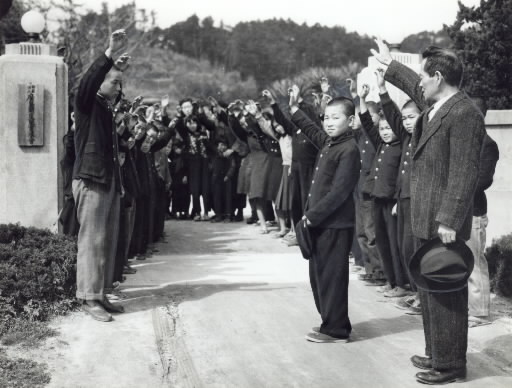The "Moral Adoption" of Hiroshima’s A-bomb Orphans, Part I [6]
Feb. 1, 2009
Children move toward independence after graduating from junior high school
by Akira Tashiro and Masami Nishimoto, Staff Reporters
“September 8th is a very important day for Japan. So far, Japan has been fine with the support of America. Now, Japan has to support itself well as an independent country. And people in Japan have to join hands and get along with people all over the world. We also have to turn over a new leaf and try hard with ardent hopes to make our way for the future.” [By a second-year junior high school student, on September 13, 1951]
A 13-year-old boy at the Hiroshima War Orphans Foster Home infused his letter with enthusiasm, linking the new start for postwar Japan with preparations for his own independence as a young man. On September 8, 1951 (in Japan, September 9), the Treaty of Peace with Japan was signed in San Francisco. Japan concluded the agreement with 48 other nations, including the United States and the United Kingdom.
Another boy expressed his determination to his American mother:
“Now, Japan has to stand on its own feet. I’ll also try to do anything on my own initiative. I’m making an effort to write a letter to you in English.” [By a second-year junior high school student, on May 19, 1952]
“We watched the Peace Conference proceedings that took place in San Francisco on our television set. We were very much impressed. America and Japan can work together once again to make a happy world. I hope you will visit America and get to know more about our country. We also want to visit Japan to see you.” [By a housewife, on February 10, 1952]
The normalization of relations between Japan and the U.S. was about to provide a turning point for the relationships of the moral parents and their adopted children. The Immigration and Nationality Act took effect in the U.S. in June 1952, enabling Japanese people to emigrate to the U.S. and become naturalized citizens under certain conditions. Legal adoption, which was advocated at the time the moral adoption campaign was proposed, began to seem possible. A widow wrote to her Japanese son in an excited tone:
“My dear son, I love the cherry blossoms along the Potomac River in Washington, D.C., which represent eternal friendship between America and Japan. I hope you can come to America. If I were able, I would arrange it so you could.” [On June 6, 1952]
In line with the original plan, the U.S. Hiroshima Peace Center Association, which had served as intermediary between the moral parents and adopted children, now encouraged the moral parents to legally adopt the children and provide for them. However, some of the moral parents were faced with hardships of their own. This letter was addressed to the late Sadako Yamashita, director of the Hiroshima War Orphans Foster Home:
“May I tell you that, recently, the person who seems to be managing the orphan project made the suggestion that the orphans be brought to America by their moral, adopted parents. However, I am 76 years old and have a heart ailment while my husband is 84. We might like to consider it if we were younger. I have written the project, asking them to let me know what part of my pledge for $30 a year for ten years is still due. I plan to send this money to the project so my adopted child can be supported at least through high school.” [November 13, 1952]
In August 1945, most of the adopted children were of elementary school age, in the third grade or above, and had been evacuated to rural areas outside the city of Hiroshima. By the end of the occupation period, the children at the Hiroshima War Orphans Foster Home had reached an important crossroads: their graduation from junior high school.
“How is your school life? What do you want to do in the future? Are you going to college? Please tell me if you have already made up your mind. Practice sports and study as hard as you can. These experiences will surely help you in the future.” [By a priest, on November 13, 1951]
How did his adopted son, who was about to graduate from junior high school, perceive this encouragement from his moral father? The next spring, when these children were 15, many of them, apart from the few who had seized the chance to enter high school, began following a solitary path toward independence whether they cared to or not.
Keywords
Evacuation of children
From April through July 1945, elementary schools in the city of Hiroshima organized group evacuations for their students, taking them to temples and other sites in seven districts in Hiroshima Prefecture, including the Saeki, Yamagata, and Takata Districts. According to the fourth volume of the Record of the Hiroshima A-bomb Disaster, the number of children involved in these evacuations reached 8,365.
(Originally published on July 19, 1988)








